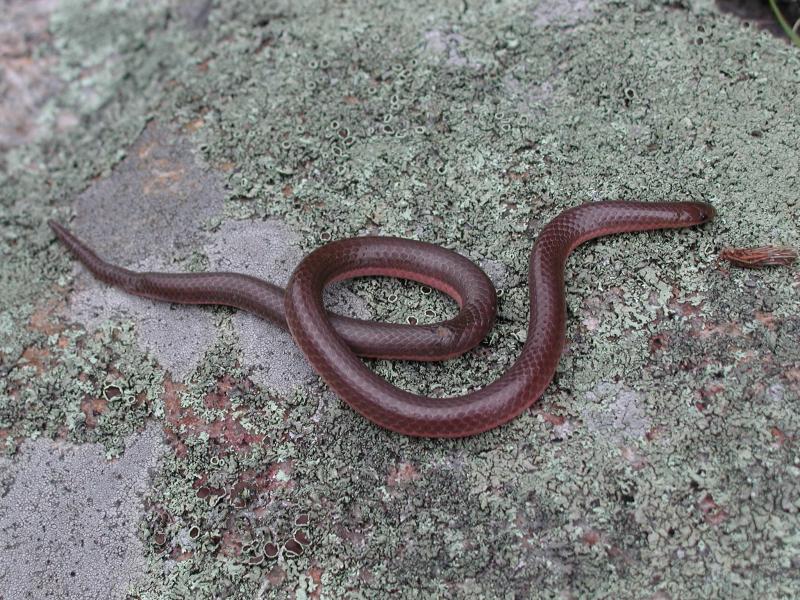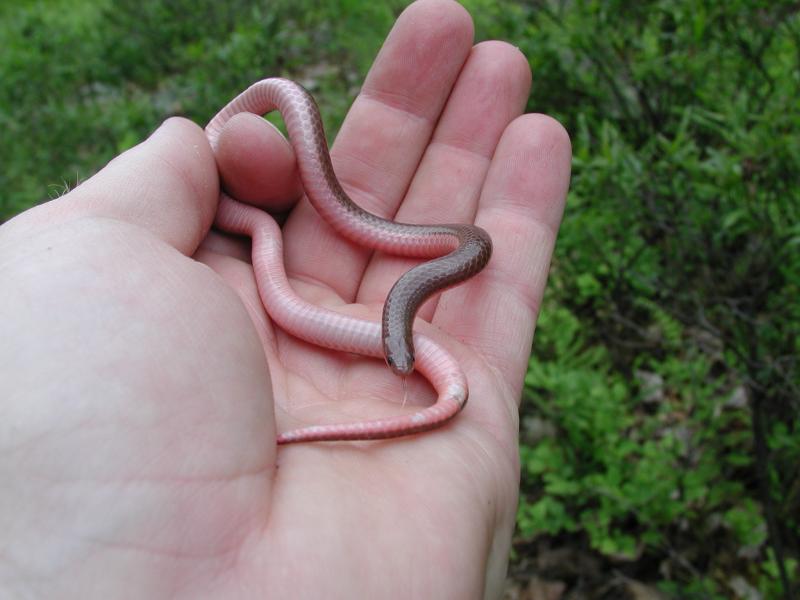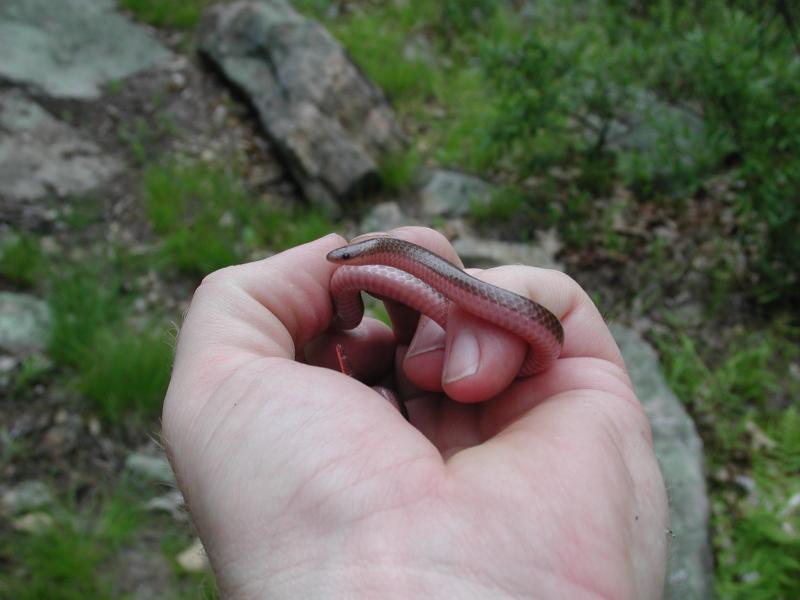Eastern Wormsnake
Carphophis amoenus (Say, 1825)
- Class
- Reptilia (Reptiles)
- Family
- Colubridae (Colubrid Snakes)
- State Protection
- Special Concern
Listed as Special Concern by New York State: at risk of becoming Threatened; not listed as Endangered or Threatened, but concern exists for its continued welfare in New York; NYS DEC may promulgate regulations as to the taking, importation, transportation, or possession as it deems necessary.
- Federal Protection
- Not Listed
- State Conservation Status Rank
- S2
Imperiled in New York - Very vulnerable to disappearing from New York due to rarity or other factors; typically 6 to 20 populations or locations in New York, very few individuals, very restricted range, few remaining acres (or miles of stream), and/or steep declines.
- Global Conservation Status Rank
- G5
Secure globally - Common in the world; widespread and abundant (but may be rare in some parts of its range).
Summary
Did you know?
In addition to resembling a worm in size and color, wormsnakes also feed on earthworms (and other small prey).
State Ranking Justification
This is a secretive species that appears to be fairly local within its state range, with fewer than 20 occurrences known. Only twelve records were reported between 1990 and 1999 within seven topographic quadrangles, despite a fairly intensive survey effort during the New York State Department of Environmental Conservation Amphibian and Reptile Atlas Project.
Short-term Trends
The species may be decreasing where it occurs, but additional data on short-term trends is needed.
Long-term Trends
The long-term trends are unknown, but habitat loss in areas where wormsnakes have been known to occur is documented and this has likely contributed to the loss of, or reduction of, populations in these localities.
Conservation and Management
Threats
Threats include habitat loss and fragmentation. Pesticides may also be a threat and Ernst (1962) reported wormsnake mortality from an application of 6% chlordane dust applied to the soil for insect control (Klemens 1993). Additional research on threats is needed.
Conservation Strategies and Management Practices
Mitigation measures to manage the adverse effects of habitat fragmentation need to be developed and implemented (New York State Department of Environmental Conservation 2006).
Research Needs
Standardized survey protocols need to be developed and, once complete, these protocols should be implemented at known and potential habitats in order to determine the character, quality, and full extent of the occupied habitat (New York State Department of Environmental Conservation 2006). Life history parameters of wormsnake populations in New York need to be determined. This includes collecting information on age and sex ratios, longevity, age at sexual maturity, survivorship of young, predator-prey relationships, and specific habitat requirements (New York State Department of Environmental Conservation 2006).
Habitat
Habitat
Although little specific habitat data exists for this species (Ernst et al. 1997 in Orr 2006), wormsnakes are reported to live in moist (mesic) forests (Gibbs et al. 2007, NatureServe 2007) and drier forests may also be inhabited (McLeod and Gates 1998). This species is often found under rocks, bark slabs, logs, leaves, or other forest litter in a variety of habitats (Barbour 1960 in Orr 2006), often along edges or ecotones (NatureServe 2007). In southern New York, particularly in the Hudson Highlands, it may be found in or near rocky summit communities or similar habitats (e.g., powerline right-of-ways through deciduous forest). It is likely present in the forests surrounding these areas, but additional habitat data is needed. Wormsnakes are also found in sandy areas, such as dry pitch pine habitats on Long Island and in the Albany Pine Bush.
Associated Ecological Communities
- Appalachian oak-hickory forest
(guide)
A hardwood forest that occurs on well-drained sites, usually on ridgetops, upper slopes, or south- and west-facing slopes. The soils are usually loams or sandy loams. This is a broadly defined forest community with several regional and edaphic variants. The dominant trees include red oak, white oak, and/or black oak. Mixed with the oaks, usually at lower densities, are pignut, shagbark, and/or sweet pignut hickory.
- Chestnut oak forest
(guide)
A hardwood forest that occurs on well-drained sites in glaciated portions of the Appalachians, and on the coastal plain. This forest is similar to the Allegheny oak forest; it is distinguished by fewer canopy dominants and a less diverse shrublayer and groundlayer flora. Dominant trees are typically chestnut oak and red oak.
- Oak-tulip tree forest
(guide)
A hardwood forest that occurs on moist, well-drained sites in southeastern New York. The dominant trees include a mixture of five or more of the following: red oak, tulip tree, American beech, black birch, red maple, scarlet oak, black oak, and white oak.
- Pitch pine-oak-heath rocky summit
(guide)
A community that occurs on warm, dry, rocky ridgetops and summits where the bedrock is non-calcareous (such as quartzite, sandstone, or schist), and the soils are more or less acidic. This community is broadly defined and includes examples that may lack pines and are dominated by scrub oak and/or heath shrubs apparently related to fire regime.
Associated Species
- Ring-necked Snake (Diadophis punctatus)
Range
New York State Distribution
This species is currently known from eight of 57 counties, although the range within these counties is likely to be restricted. The range includes Long Island, the lower Hudson Valley, including the Hudson Highlands east and west of the Hudson River, and the Albany Pine Bush.
Global Distribution
The global range extends from Illinois, Indiana, Ohio, Pennsylvania, southeastern New York and Massachusetts, south to Louisiana, Mississippi, Alabama, Georgia, and South Carolina, west to the Mississippi River and just west of the Mississippi in the vicinity of eastern Arkansas, and east to the Atlantic coast. There is an old record from west-central Florida (Ernst et al. 2003). The elevational range extends to at least 1,311 meters (4,300 feet) in North Carolina (Palmer and Braswell 1995).
Identification Comments
Identifying Characteristics
The eastern wormsnake (Carphophis amoenus) is a small (7.5-15 inches; 19-38 cm total length) (Conant and Collins 1998, Gibbs et al. 2007), fossorial (living underground) snake that resembles an earthworm (Klemens 1993). The young are 3 to 5 inches (7.5 to 12.4 cm) in length (Gibbs et al. 2007). The scales are smooth and shiny and the dorsal surface of the snake is brown, while the ventral surface and adjacent rows of dorsal scales are pink (Conant and Collins 1998, Gibbs et al. 2007). The tail terminates at a blunt spine (Gibbs et al. 2007), the head is small and flattened, tapering away from the body, and the eyes are very small (Klemens 1993). These are all adaptations for a fossorial existence (Gibbs et al. 2007).
Characters Most Useful for Identification
The small size, tapered head with small eyes, uniform shiny brown dorsal surface, and pink underside is distinctive.
Best Life Stage for Proper Identification
The adult and young differ in length, but are similar in appearance and are easily identified.
Behavior
The fossorial behavior of the wormsnake makes the chances of finding this species on the surface very rare (Gibbs et al. 2007) and locating wormsnakes usually involves looking underneath various cover items, such as rocks and logs. When handled, wormsnakes may attempt to burrow between your fingers (Gibbs et al. 2007). The species is reported from moist forests, as well as from drier habitats (McLeod and Gates 1998), and Orr (2006) determined that microhabitat soil moisture in wormsnake habitat ranged from 10% to 83% in Virginia, depending upon the season and year. Wormsnakes are susceptible to water loss through their skin and may burrow deep into the soil and become inactive during the hot summer months (Gibbs et al. 2007). Orr (2006) suggested that the distribution of wormsnakes is probably influenced by soil pH, at least at his study site in Virginia, and he found that the pH range in wormsnake habitats (5.0 to 6.9) was similar to the preferred range of the wormsnake's primary prey, the earthworm. The limits of pH tolerance of the wormsnake have not been identified, however (Orr 2006). Reports on clutch size vary, but appear to range between two and eight eggs. The eggs are probably laid in depressions under boulders or in hollow logs, likely from mid to late June (Klemens 1993) or early July. Hatching dates of eastern wormsnakes in the literature were summarized by Clark (1970), and these dates ranged between the beginning of August to mid-September and it is likely that hatching in New England and eastern New York occurs during this time (Klemens 1993). Wormsnakes have relatively small home ranges (NatureServe 2007) and the average home range size in Kentucky is reported to be 253 square meters (0.06 acres). They hibernate in rotting wood or underground, often in burrows of other animals, and they may be active both night and day (Clark 1970 in Klemens 1993).
Diet
Wormsnakes feed primarily on earthworms and soft-bodied insects (Barbour 1960). The diet is restricted to elongated prey, due to the small size of the mouth (Gibbs et al. 2007).
Best Time to See
Wormsnakes may be active from the early spring (March) through fall (October) (Gibbs et al. 2007), depending upon the weather. Mating has been reported to take place in the spring and summer (Gibbs et al. 2007), as well as the spring and fall (Clark 1970 in Klemens 1993).
- Present
- Reproducing
The time of year you would expect to find Eastern Wormsnake present and reproducing in New York.
Eastern Wormsnake Images
Taxonomy
Eastern Wormsnake
Carphophis amoenus (Say, 1825)
- Kingdom Animalia
- Phylum Craniata
- Class Reptilia
(Reptiles)
- Order Squamata
(Lizards, Snakes and Amphisbaenians)
- Family Colubridae (Colubrid Snakes)
- Order Squamata
(Lizards, Snakes and Amphisbaenians)
- Class Reptilia
(Reptiles)
- Phylum Craniata
Additional Common Names
- Eastern Worm Snake
- Worm Snake
Additional Resources
References
Barbour, R. W., M. J. Harvey, and J. W. Hardin. 1969. Home range, movement, and activity of the eastern worm snake, Carphophis amoenus amoenus. Ecology 50:470-476.
Barbour, R.W. 1960. A study of the worm snake, Carphophis amoenus, Say in Kentucky. Transactions of the Kentucky Academy of Science 21: 10-16.
Behler, J. L., and F. W. King. 1979. The Audubon Society field guide to North American reptiles and amphibians. Alfred A. Knopf, New York. 719 pp.
Burnley, J.M. 1971. Early date records of amphibians and reptiles on Long Island. Engelhardtia 4(1):1-7.
Clark, D. R., Jr. 1970. Ecological study of the worm snake Carphophis vermis (Kennicott). University of Kansas publications, Museum of Natural History19:85-194.
Collins, J. T. 1982. Amphibians and reptiles in Kansas. Second edition. Univ. Kansas Mus. Nat. Hist., Pub. Ed. Ser. 8. xiii + 356 pp.
Collins, J. T. 1991. Viewpoint: a new taxonomic arrangement for some North American amphibians and reptiles. SSAR Herpetol. Review 22:42-43.
Conant, R., and J. T. Collins. 1998. A field guide to reptiles and amphibians: eastern and central North America. Third edition, expanded. Houghton Mifflin Co., Boston, Massachusetts. 616 pp.
DeGraaf, R. M., and D. D. Rudis. 1983a. Amphibians and reptiles of New England. Habitats and natural history. Univ. Massachusetts Press. vii + 83 pp.
DeGraaf, R.M. and D.D. Rudis. 1981. Forest habitat for reptiles and amphibians of the northeast. United States Department of Agriculture, Forest Service Eastern Region, Milwaukee, WI. 239 pp.
Eckel, E.C. and F.C. Paulmier. 1902. Catalogue of New York reptiles and batrachians. New York State Museum Bull. No. 51. Albany, NY.
Ernst, C. H., J. M. Orr, and T. R. Creque. 2003b. Carphophis amoenus. Catalogue of American Amphibians and Reptiles 774:1-7.
Ernst, C.H., S.C. Belfit, S.W. Sekscienski, and A.F. Laemmerzahl. 1997. The amphibians and reptiles of Ft. Belvoir and northern Virginia. Bull. Maryland Herpetol. Soc. 33: 1-62.
Ernst, S.G. 1962. Notes on the life history of the eastern ringneck snake. Turtox News 40(10): 266-267.
Gibbs, J.P., A.R. Breisch, P.K. Ducey, G. Johnson, J.L. Behler, and R.C. Bothner. 2007. The amphibians and reptiles of New York State. Oxford University Press, NY.
Green, N. B., and T. K. Pauley. 1987. Amphibians and reptiles in West Virginia. University of Pittsburgh Press, Pittsburgh, Pennsylvania. xi + 241 pp.
Klemens, M.W. 1993. Amphibians and Reptiles of Connecticut and Adjacent Regions. State Geological and Natural History Survey of Connecticut, Bulletin No. 112.
McLeod, R.F., and J.E. Gates. 1998. Response of herpetofaunal communities to forest cutting and burning at Chesapeake Farms, Maryland. American Midland Naturalist 139: 164-177.
Minton, S. A., Jr. 1972. Amphibians and reptiles of Indiana. Indiana Academy Science Monographs 3. v + 346 pp.
Mount, R. H. 1975. The reptiles and amphibians of Alabama. Auburn University Agricultural Experiment Station, Auburn, Alabama. vii + 347 pp.
NatureServe. 2007. NatureServe Explorer: An online encyclopedia of life [web application]. Version 6.1. NatureServe, Arlington, Virginia. Available http://www.natureserve.org/explorer. (Accessed: December 19, 2007).
New York Natural Heritage Program. 2024. New York Natural Heritage Program Databases. Albany, NY.
New York State Department of Environmental Conservation, Division of Fish, Wildlife, and Marine Resources. 2006. New York State Comprehensive Wildlife Conservation Strategy. Albany, NY: New York State Department of Environmental Conservation.
New York State Department of Environmental Conservation. 1985. Checklist of the amphibians, reptiles, birds, and mammals of New York State, including their protective status. Nongame Unit. Wildlife Resources Center. Delmar, NY.
Orr, John M. 2006. Microhabitat use by the Eastern worm snake, Carphophis amoenus. Hepetological Bulletin. 97: 29-35.
Palmer, W. M., and A. L. Braswell. 1995. Reptiles of North Carolina. North Carolina State Museum of Natural Sciences, University of North Carolina Press, Chapel Hill, North Carolina.
Reilly, E.M. 1955. Snakes of New York. New York State Conservationist: 22-23 and 26.
Schlauch, F.C. and J.M. Burnley. 1972. Distributional survey of the indigenous Herpetozoans of Long Island. Revised edition. Engelhardtia 5(3):13-17.
Links
About This Guide
Information for this guide was last updated on: January 10, 2011
Please cite this page as:
New York Natural Heritage Program. 2024.
Online Conservation Guide for
Carphophis amoenus.
Available from: https://guides.nynhp.org/eastern-wormsnake/.
Accessed July 27, 2024.


